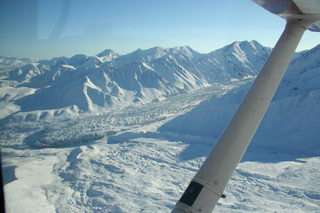Chance discovery: Alaska Range glacier surges

There is evidence that the McGinnis Glacier, a little-known tongue of ice in the central Alaska Range, has surged. Assistant Professor of Physics Martin Truffer recently noticed the lower portion of the glacier was covered in cracks, crevasses, and pinnacles of ice--all telltale signs that the glacier has recently slid forward at higher than normal rates. It has not been determined whether the glacier continues to surge.
Truffer, of the Geophysical Institute's Snow Ice and Permafrost Group, is having difficulty finding evidence of the glacier's history. He says the glacier hasn't been on anyone's radar screen for some time. Much of what has been written about the glacier is that it was covered with debris after several landslides broke loose from Mount McGinnis after the 2002 Denali Fault earthquake. In fact, that's what prompted Truffer to explore the glacier just a few days ago on a recreational snowmachining trip with friends.
"We were going to look at the landslide area and instead we saw that the entire glacier had surged. It was completely by chance," he said.
In a small aircraft on March 13, Truffer flew over McGinnis Glacier with Professor Emeritus Will Harrison to confirm the signs of the glacier's surge. The glaciologists saw trim lines high up on the glacier and accordion-like crunching at its base. A surge starts high up on a glacier and then propagates in a wave down the length of the glacier. Truffer says surging is unusual, however the Alaska Range is unique in that there are several glaciers located there that experience this. The most well known surging glacier in Alaska is the nearby Black Rapids Glacier, which advanced within a half a mile of the Richardson Highway in 1936.
Truffer says it's unfortunate that little is known about McGinnis Glacier. If the latest discovery could be compared to previous records, the surge could tell scientists much more. In the mean time, the Snow, Ice and Permafrost Group hopes to send a crew to McGinnis Glacier, located about 100 miles south of Fairbanks, to observe the surge and gather data.
Source: University of Alaska Fairbanks















